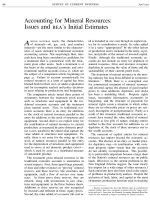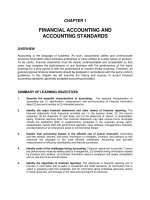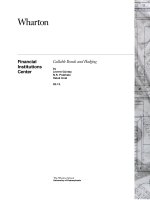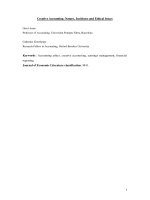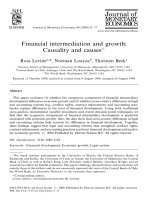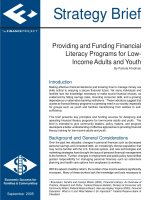Critical Financial Accounting Problems Issues and Solutions_2 pot
Bạn đang xem bản rút gọn của tài liệu. Xem và tải ngay bản đầy đủ của tài liệu tại đây (190.07 KB, 20 trang )
6 Critical Financial Accounting Problems
Exhibit 1.1
Teta Company: Schedule of Bond Discount Amortization, Effective
Interest Method, Semi-Annual Interest Payments, 12% Bonds Sold to
Yield 14%
(a) $200,000 (face value) ϫ 0.12 (stated rate) ϫ
1
⁄
2
year
(b) Previous book value ϫ 0.14 (effective rate) ϫ
1
⁄
2
year
(c) (b) Ϫ (a)
(d) Previous book value ϩ (c)
Carrying Value ϭ Face Value minus any unamortized discount
plus any unamortized premium
Bond Interest Paid ϭ Face Amount of Bonds ϫ Stated Interest Rate
The computation of the bond interest expense and discount amortization
schedule is shown in Exhibit 1.1. It is used on June 30, 1996, to make
the following entry:
Bond Interest Expense $13,016.69
Discount on Bonds Payable $1,016.69
Cash $12,000.00
The following entry is made on December 31, 1996:
Bond Interest Expense $13,087.86
Long-Term Liabilities 7
Discount on Bonds Payable $1,087.86
Cash $12,000.00
Effective Interest Method and Bonds Issued at a
Premium
To illustrate, assume that on January 1, 1996, the Smith Company
issued $200,000 of five-year bonds paying semi-annual interest with a
stated rate of 12% and an effective interest rate of 10%. The premium
may be computed as follows:
1. Present Value of principal: $200,000 ϫ 0.613913 ϭ $122,782.60
2. Present Value of interest: $12,000 ϫ 7.721735 ϭ $92,660.82
3. Selling Price $215,443.42
4. Face Value $200,000.00
5. Premium $15,443.42
The journal entry to record the issuance of the bonds follows:
Cash $215,443.42
Premium on Bonds Payable $15,442.42
Bonds Payable $200,000.00
The computation of the bond interest expense and premium amortization
schedule is shown in Exhibit 1.2. It is used on June 30, 1996, to make
the following entry:
Bond Interest Expense $10,772.17
Premium on Bonds Payable $1,227.83
Cash $12,000.00
Accruing Bond Interest
When interest payment dates and the date of the financial statements
issuance are not the same, there is a need for accounting for accrual of
interest and a partial premium or discount amortization to be made at
the end of the fiscal year. For example, let’s assume that the previous
example of the Smith Company includes a need to report the financial
statements by the end of March 1996. In that case the matching concept
8 Critical Financial Accounting Problems
Exhibit 1.2
Smith Company: Schedule of Bond Premium Amortization, Effective
Interest Method, Semi-Annual Interest Payments, 12% Bonds Sold to
Yield 10%
(a) $200,000 (face value) ϫ 0.12 (stated rate) ϫ
1
⁄
2
year
(b) Previous book value ϫ 0.14 (effective rate) ϫ
1
⁄
2
year
(c) (a) Ϫ (b)
(d) Previous book value Ϫ (c)
dictates a proration over three months of interest and premium amortized
as follow:
1. Premium amortized (1,227.83 ϫ 3/6) $613.915
2. Interest Expense (10,772.17 ϫ 3/6) $5,386.085
3. Interest Payable (12,000 ϫ 3/6) $6,000.000
The journal entry at the end of March 1996 to record the accrual is as
follows:
Interest Expense $5,386.085
Premium on Bonds Payable $613.915
Interest Payable $6,000.000
Long-Term Liabilities 9
Costs of Issuing Bonds
Various expenditures may be required for the issuance of bonds, in-
cluding legal and accounting fees, printing costs and registration fees.
The present GAAP requirement is to defer the costs of issuing bonds
and amortize over the life of the bond issue by the straight-line method.
To illustrate, assume that on January 1, 1996, Tucker Company issued
five-year bonds with a face value of $10,000,000 and a price of
$10,500,000. Expenditures connected with the issue amounted to
$250,000. The journal entry to record the issue is as follows:
Cash (10,500,000 Ϫ 250,000) $10,250,000
Unamortized Bond Issue Costs $250,000
Premium on Bonds Payable $500,000
Bonds Payable $10,000,000
The journal entry on December 31, 1996, to record the amortization is
as follows:
Bond Interest Expense $50,000
Unamortized Bond Issue
Costs $50,000
(250,000/5)
The unamortized bond issue costs are to be disclosed as deferred charge
on other assets.
Bonds Issued with Detachable Warrants
Bonds issued with detachable warrants allow the bondholder to acquire
a specific number of common shares at a given price and a given time.
The bonds are known as bonds with stock warrants or stock rights. The
proceeds of the bonds are allocated to both the bonds and the warrants
as follows:
1. Amount
Allocated
to Bonds
ϭ
Market Value of Bonds without Warrants
Market Value of Bonds without Warrants
ϩ Market Value of Warrants
ϫ
Issuance
Price
10 Critical Financial Accounting Problems
2. Amount
Allocated
to Warrant
ϭ
Market Value of Warrant
Market Value of Bonds Without Warrants
ϩ Market Value of Warrants
ϫ
Issuance
Price
To illustrate, let’s assume that the Dimitra Company sold $400,000 of
12% bonds at 101 or $404,000. Each $1,000 bond is issued with 10
detachable warrants that entitle the holder to acquire one share of $10
par common stock for $30 per share. Following the issuance the bonds
without the rights attached (ex. rights) were quoted at 99 and the warrants
at $3 each. The proceeds of the bonds are allocated as follows:
1. Amount
Allocated
to Bonds
ϭ
$990 ϫ 400
(990 ϫ 400) ϩ (3 ϫ 400 ϫ 10)
ϫ $404,000 ϭ $392,117.68
2. Amount
Allocated
to Warrant
ϭ
$3 ϫ 400 ϫ 10
(990 ϫ 400) ϩ (3 ϫ 400 ϫ 10)
ϫ $404,000 ϭ $11,882.396
As a result the following entry may be made:
Cash $404,000.00
Discount on Bonds Payable
(400000 Ϫ 392117.68) $7,882.32
Bonds Payable $400,000.00
Common Stock Warrants 11,882.32
The value of each warrant is $2.96 (11882.32/4000). Assuming 100 war-
rants were exercised, the following entry will be made:
Cash ($30 ϫ 100) $3,000.00
Common Stock Warranty
(2.97 ϫ 100) $297.00
Common Stock (10 ϫ 100) $1,000.00
Additional Paid-in Capital
on Common Stock $2,297.00
If all the remaining warrants expire, the following entry is made:
Long-Term Liabilities 11
Common Stock Warrants $11,585.32
Additional Paid-in Capital
on Common Stock $11,585.32
Accounting for Convertible Bonds and Preferred Stock
Convertible bonds are bonds that can be converted into common
stocks, allowing the bondholder (a creditor) to become a stockholder by
exchanging the bonds for a specified number of shares. Issuance of con-
vertible bonds may be motivated by making an increase in equity later
or an increase in bonds now, more attractive through the conversion
feature. Other factors that may motivate a firm to issue convertible bonds
is related to its desire to:
1. Avoid the downward price pressure on its stock that placing a large new
issue of common stock on the market would cause
2. Avoid the direct sale of common stock when it believes its stock currently
is undervalued in the market
3. Penetrate that segment of the capital market that is unwilling or unable to
participate in a direct common stock issue
4. Minimize the costs associated with selling securities.
1
The first accounting problem facing convertible debts is the accounting
at the time of issuance. Following APB Opinion No. 14,
2
accounting for
convertible debt at the time of issuance treats it solely as a debt, with
the discount or premium amortized to its maturity date. The second ac-
counting problem arises at the time of conversion. Two methods may be
used for recording the conversion.
1. Book Value Method. Under this method the stockholders’ equity (common
stock and additional paid-in capital) is credited at the book value of con-
vertible bonds on the date of conversion, resulting in no gain or loss being
recognized.
2. Market Value Method. Under this method the stockholders’ equity (common
stock and additional paid-in capital) is credited at the market value of the
shares issued on the date of conversion, resulting in the recognition of a gain
or loss to be included as ordinary rather than extraordinary income.
To illustrate both methods, let’s assume that the Bulls Corporation has
issued $20,000 worth of convertible bonds that have now a book value
12 Critical Financial Accounting Problems
of $21,000. Each $1,000 bond is convertible into 20 shares of common
stock (par value $40). At the time of conversion, interest had been paid
on the debt, and the market value of the common stock is $60 per share.
The entries under both methods would be:
A. Under the Book Value Method:
Bonds Payable $20,000
Premium on Bonds Payable $1,000
Common Stock
(40 ϫ 20 ϫ 20) $16,000
Additional Paid-in Capital
from Bond Conversion $5,000
(21,000 Ϫ 16,000)
B. Under the Market Value Method:
Bonds Payable $20,000
Premium on Bonds Payable $1,000
Loss on Conversion
(48,000 Ϫ 21,000) $27,000
Common Stock
(40 ϫ 20 ϫ 20) $16,000
Additional Paid-in Capital
from Bond Conversion $32,000
(40 ϫ 20 ϫ 40)
Let’s assume that in the previous example the firm has agreed to pay an
extra $5,000 to the bondholders to induce conversion; the following entry
under the book value method will be made:
Debt Conversion Expense $5,000
Bonds Payable $20,000
Premium on Bonds Payable $1,000
Common Stock $16,000
Additional Paid-in Capital $5,000
Cash $5,000
The cash used to induce conversion is treated as an ordinary expense of
the current period.
Upon retirement of a convertible debt, the difference between the cash
acquisition price of the debt and its carrying amount is treated as an
Long-Term Liabilities 13
extraordinary gain or loss on extinguishment of debt.
3
The book value
is generally preferred because it avoids the type of manipulation of in-
come through gain or loss as permitted under the market value method.
However, for convertible preferred stock, only the book value method is
permitted for conversion where:
a. Convertible preferred stock and additional paid-in capital is debited.
b. Common stock and additional paid-in capital (in case an excess exists) is
credited.
c. Retained earning is debited if the par value of the common stock exceeds
the par value of preferred stock.
To illustrate, let’s assume that the Green Company issued 5,000 shares
of common stock (par value $10) upon conversion of 5,000 shares of
preferred stock (par value $5) that has been previously used with a pre-
mium of $800. The entry is as follows:
Convertible Preferred Stock
(5,000 ϫ 5) $25,000
Paid-in Capital in Excess of Par
(Premium on Preferred Stock) $800
Retained Earnings
(50,000 Ϫ 25,800) $24,200
Common Stock
(5,000 ϫ 10) $50,000
Some states require, however, that the additional return used to induce
conversion should be debited to paid-in capital.
ACCOUNTING FOR EXTINGUISHMENT AND
DEFEASANCE
Long-term debt may be retired either through an extinguishment of
debt (Reacquisition of Debt) or a defeasance of debt (In-Substance De-
feasance of Debt). Both practices are examined next.
Reacquisition of Debt
Bonds may be reacquired at maturity or prior to maturity. If the bonds
are reacquired at maturity, the premium or discount and issue costs are
14 Critical Financial Accounting Problems
fully amortized, and the face value of the bond is equal to the market
value at the time resulting in no gain or loss.
If the bonds are retired before maturity or replaced with a new issue
(refunding) a different situation arises. First, the net carrying amount of
the bonds is adjusted for amortized premium, discount and cost of is-
suance. Second, the difference between the net carrying amount and the
reacquisition price (call price) is either a gain or loss from extinguish-
ment. All material gains and losses from debt extinguishment (both re-
tirements and refunding) are classified as extraordinary item in the year
of cancellation. To illustrate, let’s assume that the Mavrides Corporation
had issued $200,000 worth of 10-year bonds paying 12% at 97 on Jan-
uary 1, 1995. The bonds, paying interest on January 1 and July 1, and
callable at 105 plus accrued interest, were recalled on June 30, 2000.
Two entries are required. The first entry is used to record the current
interest expense as well as the amortization of the expired discount, is
as follows:
Interest Expense $12,300
Discount on Bonds Payable
(6000 / 10) ϫ
1
⁄
2
$300
Interest Payable
(200,000 ϫ .12 ϫ
1
⁄
2
) $12,000
The second entry, used to record the reacquisition of debt, is as follows:
Bonds Payable $200,000
Interest Payable $12,000
Extraordinary loss on
Bond Redemption $12,700
Discount on Bonds Payable $2,700
Cash $222,000
where:
a. the discount on bonds payable is computed as
1. The original discount $6,000
2. Amortized on a straight-line
basis for 5
1
⁄
2
years:
5.5 ϫ 600 ($3,300)
Long-Term Liabilities 15
3. Unamortized discount $2,700
b. Cash ϭ $200,000 ϫ 1.05 ϩ 12,000
c. Extraordinary loss on bond redemption:
1. Call price (excluding interest) $210,000
2. Less: Face Value $200,000
unamortized discount ($2,700)
($197,300)
$12,700
In-Substance Defeasance
In-substance defeasance of debt is an arrangement whereby the debtor
places cash or purchased securities in an irrevocable trust to be used
solely to pay off the interest and principal of debt. To illustrate in-
substance defeasance of debt, let’s assume that on January 1, 1996, The
Das Company issued $100,000 of five-year, 12% bonds that yield 10%.
On December 31, 1998, when the book value of the bonds is
$103,545.92, The Das Company purchased $96,545.92 in $100,000, 12%
U.S. government bonds to service the bond interest and principal and
extinguish its debt. The journal entry to record this extinguishment is as
follows:
Bonds Payable $100,000.00
Premium on Bonds Payable $ 3,545.92
Cash $96,545.92
Extraordinary Gain on
Bond Extinguishment $7,000.00
LONG-TERM NOTES PAYABLE
Long-term notes differ form short-term notes on the basis of different
maturities. They differ from long-term bonds on the term of tradability
on organized public securities markets. Like a bond, a note payable is
recorded at the present value of its future interest and principal cash
flows, with any discount or premium amortized over the life of the note.
Similarly, interest expense is recorded over the life of the note on the
basis of the effective interest method. Examples of issuance of long-term
notes payable follow:
16 Critical Financial Accounting Problems
Issuance of a Note at Face Value
Let’s return to the section on Bonds Payable and assume the same
facts for the Katori Company except that the firm issued a long-term
note rather than bonds. Because the stated rate and the effective rate are
the same, the present value of the note and its face value at the time of
issuance are the same, resulting in no premium or discount. Accordingly,
the entry at the time of issuance is as follows:
Cash $200,000
Notes Payable $200,000
On July 1, 1996, to record the first semi-annual interest payment of
$9,000 (200000 ϫ 9% ϫ
1
⁄
2
):
Interest Expense $9,000
Cash $9,000
Issuance of a Note at Other than Face Value and Zero
Interest
Notes issued at other than face value and at zero interest are known
as zero coupon bonds. The difference between the face value and the
cash received (present value) is either a discount or premium to be am-
ortized to interest expense over the life of the note. To illustrate, let’s
assume that the Ignacius Corporation issued three-year, $20,000, zero
coupon bonds for $15,443.60, that is, with a discount of $4,556.40. The
present value of the note is $15,443.60. Therefore 15,443.60 equals pres-
ent value of three-year at interest rate (i) of $20,000.
$15,443.60
Present value at interest rate (i) for 3 years ϭϭ0.77218
$20,0000.00
The present value table shows that 0.77218 is the present value of a $1
for three periods at 9%. Therefore, the implicit interest rate is 9%. Ex-
hibit 1.3 shows the amortization of the note discount using the effective
interest method. The two main entries follow:
1. At the time of issuance
Cash $15,443.60
Long-Term Liabilities 17
Exhibit 1.3
Schedule of Note Discount Amortization, Effective Interest Method, 10%
Note Discounted at 9%
(a) ϭ $15,443.60 ϫ .09 ϭ $1,389.924
(b) ϭ (a) Ϫ 0
(c) ϭ $15,443.60 ϩ $1,389.924
(d) ϭ rounded
Discount on Notes Payable $4,556.40
Notes Payable $20,000.00
2. At the end of the first year
Interest Expense $1,389.924
Discount on Notes Payable $1,389.924
Issuance of a Note at Other than Face Value and with
Interest
Let’s assume that the Ignacius Corporation issues now a $20,000,
three-year note bearing a stated interest of 10%. The market rate for a
similar note is 12%.
The present value of the note is equal to:
a. the present value of the principal ϭ $20,000(0.7118) ϭ $14,326.00
b. the present value of the interest ϭ $2,000(2.40183) ϭ $ 4,803.66
c. the present value of the note $19,039.66
The face value of the note is equal to $20,000
The discount is equal to ($20,000 Ϫ $19,039.66) ϭ $ 960.34
Therefore, at the time of issuance, the following entry is made:
Cash $19,039.66
18 Critical Financial Accounting Problems
Exhibit 1.4
Schedule of Note Discount Amortization, 10% Note Discounted at 12%
(a) ϭ $20,000 ϫ 0.10 ϭ $2,000
(b) ϭ $19,039.66 ϫ 0.12 ϭ $2,284.759
(c) ϭ (b) Ϫ (a)
(d) ϭ $19,039.66 ϩ (c)
Discount on Notes Payable $960.34
Notes Payable $20,000
Exhibit 1.4 shows the amortization of the note discount using the
effective interest method. The entry at the end of the year is as follows:
Interest Expense $2,284.759
Discount on Bonds Payable $284.759
Cash $2,000.000
Issuance of Notes in Exchange for Cash and Rights or
Privileges
Notes may be issued for cash and include special rights or privileges.
One example of rights or privileges is the right for the holders of the
note to buy certain goods from the company at lower than the prevailing
prices. The difference between the present value of the note and the
amount of cash received is recorded as a discount on the note to be
debited and an unearned revenue to be credited. The discount is to be
amortized as a charge to interest expense using the effective interest
method. The unearned revenue is amortized as revenue over the life of
the contract on the basis of appropriate revenue recognition criteria; for
example, in the same proportion as the period sales to total sales to the
customers.
Let’s assume that the Clinton Company borrowed $200,000 by issuing
Long-Term Liabilities 19
a three-year, non-interest-bearing note to a customer that allows the cus-
tomer to buy equal amount of goods from the Clinton Company at re-
duced prices over a 10-year period. The company’s incremental
borrowing rate is 12%. Therefore the present value of the note is
$142,356 (200000 ϫ 0.71180).
Following are the entries made:
A. At the time of issuance
Cash $200,000
Discount on Notes Payable $57,644
(200,000 – 142,356)
Notes Payable $200,000
Unearned Revenue $57,644
B. At the end of the first year
Interest Expense (142,356 ϫ
.12) $17,082.72
Discount on Notes Payable $17,082.72
Unearned Revenue (57,644 / 10) $5,764.40
Sales Revenue $5,764.40
C. End of the second year
Interest Expense
[(142,356 ϩ 17,082.72) ϫ .12] $19,132.646
Discount on Notes Payable $19,132.646
Unearned Revenue $ 5,764.40
Sales Revenue $5,764.40
Issuance of Notes in Exchange for Property, Goods or
Services
Notes may be issued in exchange for property, goods or services. The
stated interest rate is presumed fair unless:
1. No interest rate is stated, or
2. The stated interest rate is unreasonable, or
3. The face value of the note is materially different from the current cash sales
price of the property, goods or service, or from the current market value of
the note.
20 Critical Financial Accounting Problems
In this case, the fair market value of the note is used as the present value
of the note. When there is no stated interest rate, the interest element is
the difference between the face value of the note and the fair value of
the property.
To illustrate, let’s assume that on January 1, 1996, the Weygandt Com-
pany purchased equipment with a useful life of five years from the Zribi
Company, for a non-interest-bearing, $30,000 five-year note. The Wey-
gandt Company’s incremental borrowing rate is 12%. Therefore, the
present value of $30,000 to be repaid at the end of five years at 12% is
$17,022.81 (30000 ϫ 0.567427). The following entries are made:
1. At the date of issuance
Equipment $17,022.81
Discount on Notes Payable $12,977.19
Notes Payable $30,000.00
2. At the end of the first year
Interest Expense
[(30,000 Ϫ 12,977.19) ϫ .12] $2,042.73
Discount on Notes Payable $2,042.73
Depreciation Expense $3,404.56
Accumulated Depreciation $3,404.56
3. At the end of the second year
Interest Expense $1797.60
[(30,000 Ϫ (12,977.19 ϩ
2,042.73)) ϫ .12]
Discount on Notes Payable $1797.60
Depreciation Expense $3,404.56
Accumulated Depreciation $3,404.56
Issuance of Notes with Imputed Interest
If the stated rate is found to be unreasonable, an imputed interest rate
is required, leading to a discount or a premium to be amortized. For
example, let’s assume that on December 31, 1996, the Pegg Company
issued a note to the Alvertos Company, for the purchase of a building,
with a face value of $600,000, a due date of December 1, 2000 and a
stated interest rate of 2%. The market conditions dictated than an 8%
interest rate should be imputed for the case.
Long-Term Liabilities 21
Exhibit 1.5
Schedule of Note Discount Amortization with Imputed Interest
(a) ϭ $600,000 ϫ 2% ϭ $12,000
(b) ϭ $456,260.52 ϫ 8% ϭ $36,500.841
(c) ϭ $36,500.841 Ϫ $12,000 ϭ $24,500.841
A. The present value of the note is equal to:
1. Present value of $600,000 due in 5 years
at 6% per year ϭ 600,000 ϫ .68058 ϭ $408,348.00
2. Present value of $12,000 interest payable
per year for 5 years at 8% ϭ 12,000 ϫ
3.99271 ϭ $47,912.52
3. Present value of the note ϭ $456,260.52
B. The face value of the note is equal to $600,000.00
C. The discount of the note is equal to (600,000 Ϫ
456,260.52)
$143,739.48
Therefore the entry at the date of issuance is as follows:
Building $456,260.52
Discount on Notes Payable $143,739.48
Notes Payable $600,000.00
Exhibit 1.5 shows the schedule of note discount amortization using the
effective interest method. At the end of the first year, the entry for the
first year’s interest and discount amortization is as follows:
Interest Expense $36,508.84
22 Critical Financial Accounting Problems
Discount on Notes Payable $24,500.84
Cash $12,000.00
ACCOUNTING FOR LOAN IMPAIRMENTS
Loan impairment arises when it is probable that the creditor may not
be able to collect all of the principal and interest due on a loan. For
example, let’s assume that on December 31, 1996, the Gore Company
issued a $1,000,000, five-year, non-interest-bearing note to the First Se-
curity Bank, yielding 10% per year. At the date of the issuance the Gore
Company paid $620,920 (1,000,000 ϫ 0.62092). The following entries
were made:
A. By the creditor, the First Security Bank
Notes Receivable $1,000,000
Discount on Notes
Receivable $379,080
Cash $620,920
B. By the debtor, the Gore Company
Cash $620,920
Discount on Notes Payable $379,080
Notes Payable $1,000,000
Exhibit 1.6 shows the note discount amortization using the effective in-
terest method. Now, let’s assume that because of bad economic condi-
tions for the Gore Company, the First Security Bank estimates on
December 31, 1998, that only $800,000 is collectable at the end of the
five years. Therefore, it estimates its loss due to impairment as follows:
1. Carrying amount of the loan, 12/31/98 $751,312.20
2. Present value of $800,000 due in 3 years at
10% compounded annually (800,000 ϫ 0.75132) $601,056.00
3. Loss due to impairment (751,312.20 Ϫ 601,056) $150,256.20
Therefore, the First Security Bank made the following entry:
Bad Debt Expense $150,256.20
Allowance for Doubtful
Accounts $150,256.20
Long-Term Liabilities 23
Exhibit 1.6
First Security Bank: First Loan Amortization Schedule
(a) ϭ $620,920 ϫ 0.10 ϭ $62,092
(b) ϭ $620.920 ϩ $62,092 ϭ $683,012.00
The Gore Company does not make an entry. The First Security Bank
prepares a new schedule of discount amortization based on the new
carrying amount of $601,056. It is shown in Exhibit 1.7. The following
entries are made on Dec. 31, 1999:
A. By the First Security Bank
Discount on Notes Receivable $75,131.32
Interest Revenue $60,105.60
Allowance for Doubtful
Accounts $15,025.72
B. By the Gore Company
Interest Expense $75,131.32
Discount on Notes Payable $75,131.32
At the maturity date, on January 1, 2000, the Gore Company pays
$800,000 and the following entries are made:
A. By the First Security Bank
Cash $800,000
Allowance for Doubtful
Accounts $200,000
Notes Receivable $1,000,000
24 Critical Financial Accounting Problems
Exhibit 1.7
First Security Bank: Second Loan Amortization Schedule
(a) ϭ $601,056.00 ϫ 10% ϭ $60,105.60
(b) ϭ $601,056.00 ϩ $60,105.60 ϭ $661,161.60
B. By the Gore Company
Notes Payable $1,000,000
Cash $800,000
Gain on Extinguishment $200,000
Accounting for Troubled Debt Restructuring
As stated in FASB Statement No. 15, a troubled debt restructuring
crisis occurs when a creditor ‘‘for economic or legal reasons related to
the debtor’s financial difficulties grants a concession to the debtor that
it would not otherwise consider.’’ The troubled debt restructuring may
take one of two forms:
1. Settlement of debt at less than its carrying amount
2. Modification of terms of the debt.
Settlement of Debt
A debt may be settled by an equity or asset exchange. In either case,
the equity or the asset should be valued at its fair market value.
For example, let’s assume that on December 31, 1996, the Kurk Com-
pany exchanges 40,000 of its own shares to a bank holding a note pay-
able and accrued interest totaling $1,800,000. The accrued interest
amounts to $800,000. The shares have a par value of $10 per share and
a market price of $30 per share. At the date of equity exchange the
following entry is initiated by the Kurk Company:
Long-Term Liabilities 25
Notes Payable $1,000,000
Interest Payable $800,000
Common Stock
(40,000 ϫ 10) $400,000
Additional Paid-in Capital
(40,000 ϫ 20) $800,000
Extraordinary Gain on Debt
Restructure $600,000
At the same date, the following entry is made by the bank:
Investment in Kurk $1,200,000
Loss on Restructured Loan $600,000
Notes Receivable $1,000,000
Interest Receivable $800,000
Let’s assume now that instead of exchanging equity, the Kurk Company
decided to exchange land it bought five years ago for $800,000, and
which has a current market value of $1,000,000. In such a case, the Kurk
Company initiates the following entry:
Notes Payable $1,200,000
Interest Payable $600,000
Extraordinary Gain on Debt
Restructure $800,000
Gain on Disposal of Land $200,000
Land $800,000
At the same date, the following entry is made by the bank:
Land $1,000,000
Loss on Restructured Loan $800,000
Notes Receivable $1,000,000
Interest Receivable $800,000
In both the asset and equity exchange, the bank would have changed the
loss (or gain) on a restructured loan to allowance for doubtful accounts
if an allowance was available.


